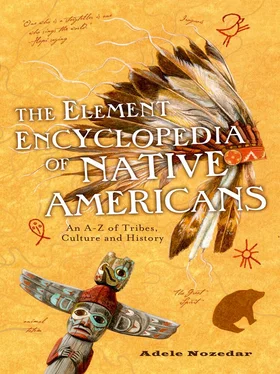The Carlisle Indian School was the first of these educational establishments, founded in Carlisle, Pennsylvania in 1879 by Captain Richard Henry Pratt. His aim was “ … to get the Indian away from the reservation into civilization, and when you get him there, keep him there.”
Pratt was authorized by the Federal Government to use the former Carlisle Barracks for the school. As part of the process of assimilation, it was deemed necessary to remove the Native American children from their parents and families, their traditional homes, and the way of life that they had followed for generations. In view of this fact, the Carlisle School, and others which emulated it, were situated away from the reservations.
It was suggested to the Native Americans that one of the reasons the white man had been able to dominate was that the Natives were not educated. If their children were brought up in the European way of education, and taught to read and write English, they would be better off for it. Accordingly, many Native families sent their children to the Carlisle School voluntarily. Subsequently, as 26 more schools sprang up using the example of the Carlisle School as their inspiration, the Bureau of Indian Affairsapplied more pressure in separating children from their families.
At the Carlisle School, it was initially forbidden to use any language other than English, and when they first arrived children were given new English names. Also, a young student arriving at the Carlisle School would be given an enforced haircut. Many tribes believed that cutting the hairwas a sign of mourning, and consequently the children would often weep until late into the night after this treatment. Their own clothes were taken away and replaced with formal Victorian dresses for the girls and military uniforms for the boys. There are archives of “before and after” photographs, ordered to be taken by Pratt, which were sent to Washington to show the difference in the children’s appearance to prove that all was in order.
For a student of the Carlisle School, the day’s regime was strict: the pupils were even expected to march, military-style, to their classes. The mornings were spent in academic studies (subjects included English, history, and math) and the afternoons were spent in learning skills that might be useful in adult life, such as woodwork and blacksmithing for the boys, laundering and baking for the girls. Children were inevitably schooled in the Christian faith. The rigid discipline of the Carlisle School also extended to its methods of punishment. Hard labor and confinement were usual for transgressors of the strict school rules. Children were even locked into the small cells of the former military guardhouse on the premises, sometimes for up to a week.
There were many critics of the Carlisle method of teaching, among them a former female pupil, Zitkala-Sa.
Many pupils struggled at the school—as well as the shock of separation from everything they held dear, including their parents, many died after contact with European diseases. Some 192 children, primarily from the Apachetribe, died and were buried at the school site.
One of the more successful programs of the Carlisle School was a scheme, invented by Pratt, called the Outing System. Students were sent to live with white families to observe their way of life and live within their society. After this experience students were able to train in various jobs, which eventually led to “legitimate” employment.
After Pratt retired in 1904, some of the stricter practices of the school were relaxed a little, and the emphasis shifted from the military and academic to sports and athletics. One pupil, Jim Thorpe, a Saukwhose original name was Bright Path, was a particularly brilliant sportsman, described at the time as the world’s greatest athlete. He went on to compete in the decathlon and pentathlon events at the 1912 Olympics, winning two gold medals.
The school eventually closed its doors in 1918.
1809–1868
Born in Kentucky and christened Christopher Houston Carson, Kit Carson was one of 15 children, and moved as an infant with his family to Missouri. Carson would have a colorful career, including an apprenticeship to a saddle maker at the age of 15, as part of a group of itinerant merchants headed toward Santa Fe, for whom he tended the horses, as a trapper, an explorer and guide, as an Indian agent, and as an officer in the U.S. Army, promoted to the position of General shortly before his death.
The name of Kit Carson has become legendary, used in fictionalized accounts of the Wild West in books, movies, and in several TV series.
Reservationsare governed by the Native American people who own them. So long as the state in which a reservation is situated allows gaming and gambling, then the reservation is permitted to open casinos if the owners so wish. The Reagan administration (1981–1989) placed an emphasis on the tribes becoming self-sufficient, and so those living on the reservations were keen to find new ways to try and lift the people out of the extreme poverty that affected many.
The very first tribe to open a gambling operation were the Seminolein Florida. They opened an elite bingo operation, with valuable prizes. The state tried to close down the venture, but the courts ruled in favor of it. In the early 1980s, another court case established the right for reservations to run gaming and gambling operations—this landmark case was “California vs. Cabazon Band of Mission Indians.” In 1988, reservation gambling and gaming laws were further supported by the Indian Gaming Regulatory Act. Casinos on reservations now draw significant crowds, and bring in a healthy revenue, especially since the casinos themselves often include conference facilities, hotels, and other tourist attractions.

Also called manioc, this was an important food source, particularly for the Arawak.
Also known as the Esaw or Issa, which name refers to the river running through their ancestral lands, the Catawba were at one time considered to be the most important tribe in the Carolinas. About 250 years ago there were estimated to be 5,000 tribal members in North and South Carolina. The tribe belong to the Siouxan language family.
Despite constant battles and skirmishes with other tribes in the area—including the Cherokee, the Delaware, and the Shawnee—the Catawba were, on the whole, well-disposed toward the very early European explorers and settlers. However, like many other tribes, the Catawba fell prey to the white man’s diseases—in particular, smallpox: in 1759 a severe epidemic obliterated almost half of the tribe, who had no immunity to the illness.
In 1763 the tribe were allocated a reservationof approximately 15 square miles which straddled both sides of the Catawba River. Fighting on behalf of the Americans against the British in the War of Independence, the tribe relocated to Virginia at the approach of the British troops, but returned afterwards and formed two villages on the reservation. In the early 19th century the tribe chose to lease their land to white settlers, and in 1840 they sold the entire reservation, all except for one square mile, and headed toward Cherokee country, where they found that the relationship with their old adversaries was as bad as it ever had been. Although there were instances of intermarriage between the two tribes, for the most part the Catawba returned to South Carolina.
Читать дальше













